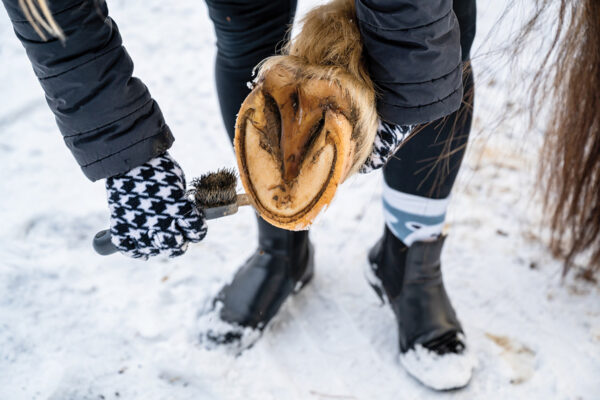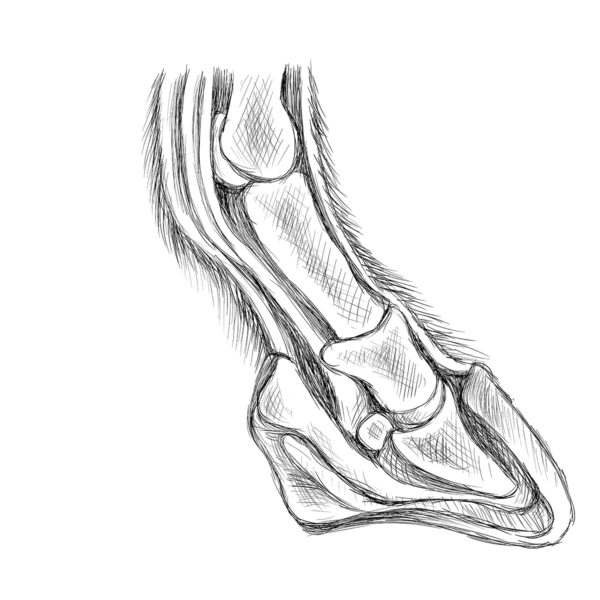
Our horse’s hooves are strong, amazing pieces of equine anatomy. Hidden inside those feet, there are some interesting things going on. Here are five astounding facts you may not know about your horse’s hoof.
1. Your Horse’s Hoof Growth Can Change Speed
Your horse’s hooves are made of keratin, the same material as your fingernails. And like your nails, your horse’s hooves grow constantly. In general, a horse grows new hoof at a rate of about 1/4 of an inch per month. At this speed, an adult horse grows a “new” hoof in about a year. New growth starts at the top where the hoof meets the hairline at what is called the coronary band.
The rate at which hooves grow depends on lots of things. For example, young horses grow hooves faster than older horses; in fact, a foal’s hooves grow at twice the speed of an adult horse!
The health of the horse, his genetics, diet, and even time of year are other important factors. Hooves tend to grow slower in the cold winter months compared to the spring. When lots of fresh grass is abundant, hooves grow faster.
2. Horses’ Hooves are Flexible
Although your horse’s feet may seem hard and rigid, the hoof is actually a flexible structure. It makes sense, since it needs to stand up to the demands of keeping a 1,000+ pound creature safe and literally sound! Again, think of your nails—sure, they’re tough, but they also bend, right? Hooves behave the same way. They expand and contact as a horse puts his full weight on each foot.
Movement mechanics aren’t the only way a hoof flexes. Environmental temperatures also result in tiny movements of the hoof. Cold weather causes hooves to contract slightly, while warmer weather makes them expand.
3. The Fabulous Frog
The bottom of a horse’s hoof is called the sole. When picking out your horse’s hooves, you’ll notice a triangular structure in the middle called the frog. How this part of the hoof got its name remains a mystery—although there are a few interesting theories based in folklore—but the functions of the frog have been intensely studied.
This part of the hoof is rubbery and acts both as a cushion for the foot and a shock absorber. Every time a horse steps down, pressure is dispersed by the frog. This is important to prevent the rigid part of the hoof from cracking apart when the horse moves. This cushioning action also acts as a pump to help with blood flow inside the hoof and up the leg. As if that’s not enough, the frog also helps with traction on slippery surfaces.
Like the outer hoof wall, the frog also grows. Some farriers might trim excess frog growth, depending on the horse and the health of the hoof in general. If not trimmed, the frog “sheds” off about once or twice a year; the old tissue will slough away and the new frog tissue will be waiting underneath, ready for action.
Who knew such a funny-named shape on the bottom of the hoof could be so important?
4. The Complex Coffin Bone

The hoof may look fairly simple from the outside, but within, it holds vital and complicated structures safe. Inside the hoof is the final bone in a horse’s leg, called the coffin bone. This bone is also refered to as P3, which is an abbreviation of its medical name: the third phalanx.
This bone is the same as the bone at the tip of your finger; your finger also has three bones in it. Essentially, horses are walking on their fingertips.
But how is the coffin bone connected to the hoof? It is suspended inside by complex Velcro-like tissue called laminae. This is a delicate, interlocking structure rich in tiny blood vessels.
The so-called “insensitive” laminae (because it has no nerve endings) is attached to the inner wall of the hoof. The sensitive laminae, filled with nerves, attaches to the coffin bone. The sensitive and insensitive laminae interlock tightly to hold the coffin bone in place inside the hoof. Woven together, they support this bone mechanically and nutritionally.
As you can imagine, the laminae are an indispensable part of the hoof structure. This is why laminitis (also called founder), an inflammation of these laminae, can be such a painful and serious hoof disease in horses. Prevention is always preferable to treatment.
5. Horseshoes in History
Did you know that horses have been wearing shoes for over 1,000 years? Nowadays, most horseshoes are made of steel or aluminum, but iron horseshoes have been unearthed at many archeological sites across the world.
Ancient Romans used unique “hipposandals” that slipped onto the horse’s foot instead of using nails—the ancient version of the glue-on shoe!
This article about horse hoof facts appeared in the November/December issue of Young Rider magazine. Click here to subscribe!


